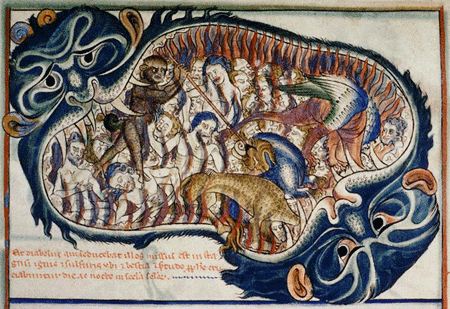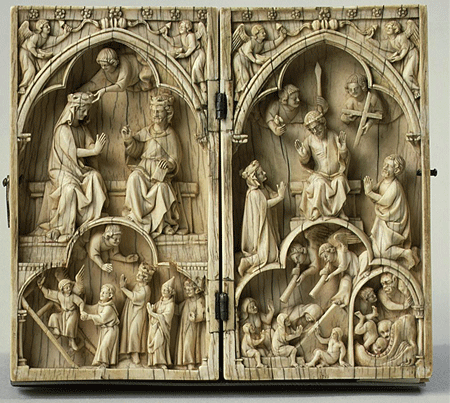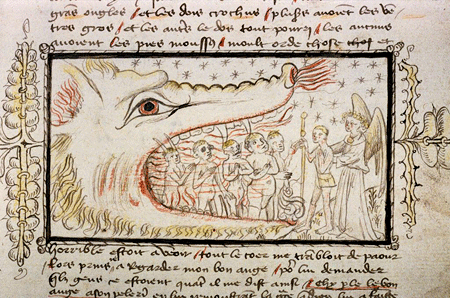Restless spirits and hungry mouths

English | Apocalypse; Folio #: fol. 021r | c. 1250-1260 | Image and original data provided by the Bodleian Library, University of Oxford.
Tradition holds that on Halloween the walls between the worlds of the living and the dead weaken and spirits walk the earth. More recently, the TV series Buffy the Vampire Slayer combined this concept with the medieval motif of the hellmouth. In the show, the hellmouth is a weak place between dimensions that attracts demons and other supernatural creatures. If it were ever to open it would signal the end of the world. Suitably inspired, we ventured to explore the theme in the ARTstor Digital Library. A simple keyword search for hellmouth led us to an array of spooky artworks dating from the 11th century to the 17th century.

English | Versions of parts of Genesis, Exodus, and Daniel, etc. (the ‘Caedmon manuscript.’) | c. 1000 AD | Image and original data provided by the Bodleian Library, University of Oxford.
While not part of Christian dogma, it’s not surprising that the hellmouth proved such a popular motif with artists, as you can’t beat the spectacle of sinners driven into hell through the enormous jaws of a great beast. The Manuscripts and Early Printed Books (Bodleian Library, University of Oxford) collection offers some of the earliest references to the hellmouth. The oldest is this image ca. 1000 of a wrathful Jesus aiming javelins at the rebel angels. The lower part of the image shows the falling figure of Lucifer and his shattered throne, ending with Lucifer again, this time in chains, nestled in the mouth of hell.

French | Diptych with Coronation of the Virgin and the Last Judgment | ca. 1260-1270 | The Metropolitan Museum of Art; The Cloisters Collection | Image and data from: The Metropolitan Museum of Art
This ivory diptych from late 13th century shows the coronation of the Virgin Mary on the left and Christ displaying the stigmata on the right. Below them, trumpet-playing angels summon the dead from their graves. The saved are ushered up to heaven and the damned are pushed down through the gates of hell. This beautiful palm-sized object, now in the collection of The Metropolitan Museum of Art, was used for private contemplation and served as a reminder of the rewards of piety and the punishments for straying.
We end with this illustration from the Prose paraphrase of Le pèlerinage de l’âme manuscript, also from the collection of the Bodleian Library, which shows a pilgrim and a guardian angel looking into the mouth of hell at the souls of the damned. A memorable tour, to say the least.

Guillaume de Deguileville; Jean Gallopez (paraphrased by) | Prose paraphrase of Le pèlerinage de l’âme (second part of the Trois Pèlerinages); Folio #: fol. 024r | 1435 | Image and original data provided by the Bodleian Library, University of Oxford.
If you find yourself bobbing for apples at a Halloween party this month, we dare you not to think about the art history of wide open jaws.
What are you afraid of? Find something to keep you up at night with this list of our spookiest posts: